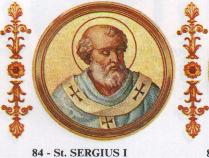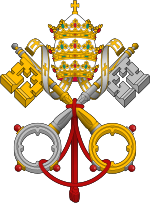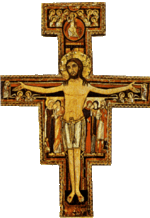Pope Sergius I
| Sergius I | |
|---|---|
 |
|
| Papacy began | December 15, 687 |
| Papacy ended | September 8, 701 |
| Predecessor | Conon |
| Successor | John VI |
| Personal details | |
| Birth name | ??? |
| Born | 650 Palermo, Sicily, Byzantine Empire |
| Died | September 8, 701 ??? |
| Other Popes named Sergius | |
Pope Saint Sergius I (c. 650 – September 8, 701) was pope from 687 to 701. Selected to end a schism between Antipope Paschal and Antipope Theodore, Sergius I ended the last disputed sede vacante of the Byzantine Papacy.
His papacy was dominated by his response to the Quinisext Council, whose canons he refused to accept. As a result of the dispute Justinian II ordered Sergius I's abduction (as his predecessor Constans II had done with Pope Martin I), but with the assistance of the exarch of Ravenna, Sergius I was able to avoid trial in Constantinople.
Contents |
Early life
Sergius I came from an Antiochene Syrian family which had settled at Palermo in Sicily. Sergius left Sicily and arrived in Rome during the pontificate of Pope Adeodatus.[1] A fellow Sicilian Pope Leo II ordained him cardinal-priest of Santa Susanna on June 27, 683 and he rose through the ranks of the clergy.[1][2] He remained cardinal-priest of S. Susanna until his selection as pope.[1]
Election
Sergius I owed his election as Pope Conon's successor to skillful intrigues against Antipope Paschal and Antipope Theodore, the other candidates. The two armed factions entered open combat before Sergius I was chosen by a group of judges, soldiers, clergy, and citizens.[3] Sergius I was brought to the Palatine imperial palace and then the Lateran.[3] The "numerical superiority" of this new faction forced Theodore from the patriarchium, whereafter he acknowledged Sergius I as pope.[3]
Paschal remained unconvinced, and while pretending to accept Sergius, sent messengers to the exarch of Ravenna John Platyn promising gold in exchange for military support.[3] The exarch arrived, demanded the gold, and looted Old St. Peter's Basilica, but departed after Sergius I's consecration.[3] Paschal was eventually confined to a monastery on charges of witchcraft.[3]
Sergius I was consecrated on December 15, 687, ending the last disputed sede vacante of the Byzantine Papacy.[4]
Papacy (687–701)
On April 10, 689, Sergius I baptised King Caedwalla of Wessex in Rome. He also ordained Saint Willibrord as bishop of the Frisians, and the Liber Pontificalis states he also ordained Berhtwald as Archbishop of Canterbury.
Sergius founded the diaconie of S. Maria in Via Lata, on the Corso from the Porta Flaminia to Capitoline Hill, encompassing a quarter of the city which developed in the eighth century.[5] He also "restored and embellished" the Eastern church of SS. Cosmas and Damian.[5]
Response to the Quinisext Council
Sergius I did not attend the Quinisext Council of 692, but sent legates (including his apocrisiarius and suffragan Basil, the bishop of Gortyna in Crete), who ended up subscribing to the canons as "holding the place of the entire synod of the Holy Roman Church".[6] Sergius I himself rejected certain canons of the Council, although he continued to support political unity with Constantinople.[7] It is unknown exactly which canons Sergius I objected to, but he declared that he would "rather die than consent to erroneous novelties".[7] Sergius I's objections, however, did not extend to the anathemization of his predecessor, Pope Honorius I, who at the time was also condemned in Western formulas.[7] The canon which declared Constantinople equal in privileges but second in honor to Rome was also probably not the point of contention as it differed little from the pronouncements of earlier councils.[7]
However, the Quinisext Council did approve all eighty-five of the Apostolic Canons, while Sergius I would only have supported the first fifty.[7] The bulk of the resistance probably stemmed from varying doctrines and practices between east and west; for example, Roman deacons were prohibited from living with their wives after ordination, Roman priests were prohibited from having married twice prior to ordination, and Roman Christians were prohibited from fasting on the Saturdays of Great Lent and allowed to consume animal blood.[7] These and other practices differed from the Trullan canons.[7]
In a symbolically important step, Sergius I declared support for the chant "Lamb of God, who takest away the sins of the world, have mercy on us" at the breaking of the Host during Mass, and restored the damaged facade mosaic in St. Peter's atrium that depicted the Worship of the Lamb; the depiction of Christ as lamb had been prohibited by the Council.[1] The Agnus Dei would have been chanted in both Greek and Latin during this period, in the same manner as the other liturgical changes of Sergius I.[8] Sergius I himself composed a litany in Greek (extant in the Athelstan Psalter to be recited on the feast of all saints.[9]
Enraged, Emperor Justinian II dispatched his magistrianus, also named Sergius, to Rome to arrest bishop John of Portus, the chief papal legate to the Third Council of Constantinople and Boniface, the papal counselor.[1] The two high ranking officials were brought to Constantinople as a warning to the pope.[1] Eventually, Justinian II ordered Sergius I's arrest and abduction to Constantinople by his notoriously violent bodyguard protospatharios Zacharias.[1] However, the militia of the exarch of Ravenna and the Duchy of Pentapolis frustrated the attempt.[10] Zacharias nearly lost his own life in an attempt to arrest Sergius I.[11] Rather than seizing upon the anti-Byzantine sentiment, Sergius I did his best to quell the uprising.[10]
Death
Sergius died on September 8, 701. He was succeeded by John VI.
Notes
| Papal styles of Pope Sergius I |
|
|---|---|
 |
|
| Reference style | His Holiness |
| Spoken style | Your Holiness |
| Religious style | Holy Father |
| Posthumous style | Saint |
- ↑ 1.0 1.1 1.2 1.3 1.4 1.5 1.6 Ekonomou, 2007, p. 223.
- ↑ Horace Mann: The lives of the popes. Vol. I pt. 2, London 1903, p. 80
- ↑ 3.0 3.1 3.2 3.3 3.4 3.5 Ekonomou, 2007, p. 216.
- ↑ Ekonomou, 2007, p. 217.
- ↑ 5.0 5.1 Ekonomou, 2007, p. 210.
- ↑ Ekonomou, 2007, p. 220.
- ↑ 7.0 7.1 7.2 7.3 7.4 7.5 7.6 Ekonomou, 2007, p. 222.
- ↑ Ekonomou, 2007, p. 250.
- ↑ Ekonomou, 2007, p. 254, 280n94.
- ↑ 10.0 10.1 Ekonomou, 2007, p. 224.
- ↑ Ekonomou, 2007, p. 44.
References
- Ekonomou, Andrew J. 2007. Byzantine Rome and the Greek Popes: Eastern influences on Rome and the papacy from Gregory the Great to Zacharias, A.D. 590–752. Lexington Books.
| Catholic Church titles | ||
|---|---|---|
| Preceded by Conon |
Pope 687–701 |
Succeeded by John VI |
|
|||||||||||||||||||||||||||||||||||||||||||||
|
|||||||||||||||||||||||||||||||||||||||||

